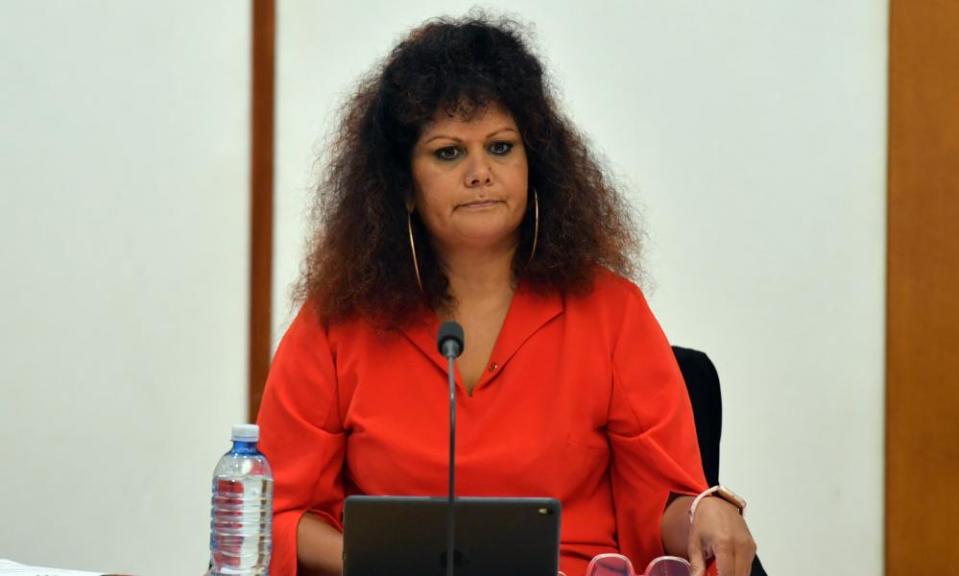Federal government in talks to buy out licences for Aboriginal flag design, Senate hears
The non-Indigenous company at the centre of the furore over who has the right to reproduce the Aboriginal flag design has confirmed it is in negotiations with the federal government about the acquisition of its exclusive licence, a Senate inquiry has heard.
WAM Clothing’s co-owner, Ben Wooster, also confirmed on Monday that its clothing bearing the Aboriginal flag was made in Indonesia.
Related: Freeing the Aboriginal flag: how a 'uniting symbol' ended up in the hands of the few
The inquiry heard WAM had entered discussions with the National Indigenous Australians Agency (NIAA) in relation to the acquisition of the flag’s copyright.
The agency subsequently confirmed talks about acquiring the copyright and licences were ongoing.
“Delicate, sensitive and complex negotiations” have been underway since the middle of 2019, NIAA chief executive Ray Griggs said.
“There is exceptional goodwill and trust being displayed” by all parties to the negotiations, which remain confidential at the request of the flag’s creator, Harold Thomas, Griggs said. WAM Clothing and other licence holders have all been involved.
“There is a desire from all parties to resolve this as soon as possible in a way that can end the divisiveness.”
WAM co-owner Semele Moore could not answer other questions about the company’s current arrangements with Thomas – the Luritja artist who created the flag in 1971 – or the extent of its rights and earnings, saying the details were commercially confidential.
In a tense and awkward exchange with Western Australia Labor senator Pat Dodson, who asked how many cease-and-desist letters WAM had sent to Aboriginal community organisations, Moore told the inquiry she did not know.
The inquiry chair, the Northern Territory senator and Yanyuwa woman Malarndirri McCarthy, suggested Moore could provide answers on notice, or confidentially, but Moore declined.
“Negotiations are ongoing between a number of parties and we would not intend to put in any further information on these matters,” she said.
When asked if she was able to provide a comparison of the company’s earnings over the past two financial years, Moore said: “I don’t have the information and no, I don’t intend to submit it.”
Dodson asked: “Do you intend to answer any questions?”
“I’m happy to answer questions, however the questions that you’re asking me …” Moore said before Dodson interjected, saying: “I would have thought, operating a business, you’d have those sorts of details at your fingertips.”
Moore replied: “I don’t have the files, I’m sorry, I don’t have my laptop in front of me, I can’t answer the question.”
Queensland LNP senator Amanda Stoker said it was not appropriate for the inquiry to be “delving into the business arrangements between Mr Thomas or WAM, or quite frankly anybody else”.
Related: Company that owns rights to Aboriginal flag in the spotlight at Senate inquiry
WAM Clothing was granted the exclusive licence to reproduce the Aboriginal flag on clothing, physical and digital media by its designer and copyright holder, Thomas, in November 2018.
The company has since issued infringement notices to the AFL and NRL, as well as non-profit Aboriginal organisations, for their past use of the design.
WAM is part-owned by Wooster, whose previous company, Birubi Art, was fined a record $2.3m by the federal court after finding it had breached consumer law by selling fake Aboriginal art.

In October 2018, the court found that Birubi had “made false or misleading representations that products it sold were made in Australia and hand-painted by Australian Aboriginal persons, in breach of the Australian consumer law”.
The Australian Competition and Consumer Commission (ACCC) sought a high penalty as a deterrent, and to signify the “serious cultural harm” done by fake Aboriginal art.
Birubi went into voluntary liquidation in 2017 but not before selling its assets to another company, Gifts Mate, “established and controlled by Birubi’s former director Mr Wooster”, the federal court judge, Melissa Parry, noted in her decision.
In his evidence to Monday’s inquiry, Wooster directly addressed his role as a former director with Birubi by quoting a section of Perry’s federal court judgment.
“There has never been any suggestion that Birubi or myself were dishonest,” Wooster said. “And I will add that no complaints were ever made by the ACCC against me personally.”
It is the first time WAM Clothing has spoken publicly at any length about the company’s arrangements with Thomas.
Related: AFL slugged with retrospective bill for use of Aboriginal flag as fans urged to bring their own
Earlier, the chief executive of the Arts Law Centre, Robyn Ayres, told the inquiry it was “very unique and very unusual to have a flag that is privately owned”, while a panel of legal experts was unanimous that compulsory acquisition of copyright by the government was not a good idea.
A University of Sydney law professor, Kimberlee Weatherall, said: “Everyone is really very wary about expropriating Indigenous intellectual property.”
The committee is considering the current and former copyright and licensing arrangements, who benefits from payments for its use, and the effect of those arrangements on Aboriginal organisations and communities.

 Yahoo Finance
Yahoo Finance 